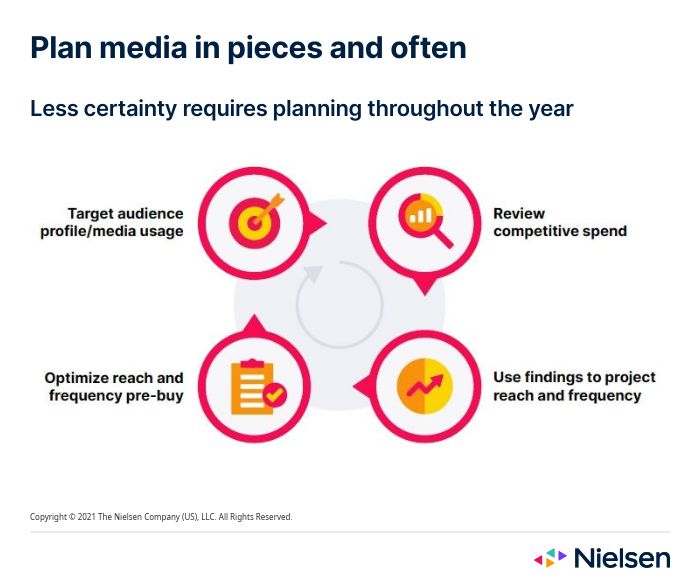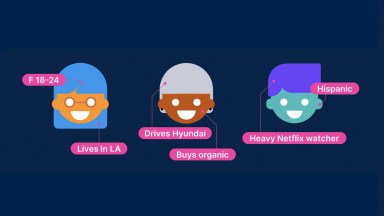Adopting an always-on mindset for media planning is key to navigating change
Even before the pandemic had an impact on media planning, it was in need of a reboot. For brands that were forced to pull back on budgets over the past 18+ months, navigating media planning will involve some level of uncertainty for the foreseeable future. The need to get back on track—and as quickly as possible—will be a priority heading into 2022. It’s important for marketers to recognize that the customary approach to media planning will be less relevant and effective both during the ongoing pandemic and in a post-pandemic world. And therein lies the challenge; break the habit of only engaging in planning once or twice a year, and quickly adopt a new, always-on approach.
Nielsen recently identified three pillars of effective media planning that marketers should focus on in order to thrive in an uncertain future—focusing on the people they’re trying to reach, connected planning and continuous planning. While each of the three pillars work deliberately together, enabling continuous planning into a brand’s strategy may give it the quickest bang for its buck—and help brands get back on track after months of ongoing disruption.
Less certainty means planning throughout the year is necessary
With the volatility of the current and future market in mind, the time to adopt a process of continuous planning is now. Steps for effective continuous planning include:
When disruption took hold at the pandemic’s outset, agile brands were better prepared to pivot to meet the changing needs and interests of consumers. Looking ahead, the days of “set it and forget it” are gone, and planning in 12-18 month cycles likely won’t be as effective going forward. Instead, marketers should continuously plan throughout the year to mirror the evolving needs of consumers—which can enable processes to run more efficiently and resources to be effectively allocated. Iterative planning—planning that involves adapting processes as a project unfolds and changing plans when necessary—can help a brand monitor, track and analyze campaign performance to identify optimization opportunities, along with what is and isn’t working. It enables marketers to pivot their strategy quickly, based on the feedback from the monitoring process and changes in scope, budget or schedule.
- Identifying the brand’s target audience and their media usage: By identifying the audience, attribution measurements can help marketers understand which channels consumers use and which advertisements create engagement.
- Review competitive spend: With that baseline understanding of the target audience, a thorough understanding of how competitors are spending their advertising dollars is key.
- Optimize, plan for and project reach & frequency: Whether using a continuity approach, flighting or pulsing—a combination of both, when frequency increases at times when the additional messaging can have a solid impact—marketers can be more effective.

Within these steps, defining the brand’s target audience and understanding what they’re engaging with—and not making decisions based solely on what is liked or what a competitor is doing—is key. Marketers should also canvass their target to understand new behaviors. With insight into both the audience and competitive spend, marketers can then accurately project reach and frequency.
Pivotal to these steps, an established process should also ensure a brand is optimizing its resources agiley within the market at all times. However, Nielsen’s Annual Marketing Survey found that 48% of respondents felt slightly or not at all confident in their ability to measure ROI. In this uncertain media world, marketers cannot reflect on how their budget performed after a tactic has been used. Instead, to prove effectiveness and allocate resources shrewdly, marketers should optimize campaigns by using outcome data in-flight—which will also maximize ROI.
Whether done manually or via machine learning tools, marketers should run optimization scenarios and find efficiencies to set the brand up for pre-buy, then take what’s been learned into activation.
The media environment is changing and evolving, and brands have to constantly adapt in order to thrive. In the months and years ahead, adaptability will remain critical for brands across all industries. Media planning needs to be nimble and fluid, while allowing marketers to revisit ideas from previous quarters to help make decisions to go forward. With a mindset of continuous planning, advertisers can prepare for what’s ahead as best as possible during uncertain times.
For additional insights, download our Embrace change in your media planning: 3 pillars of effectiveness guide.



